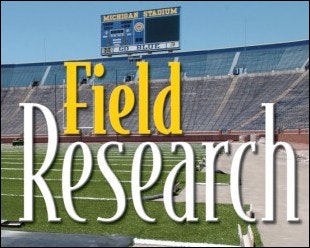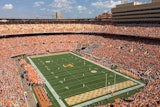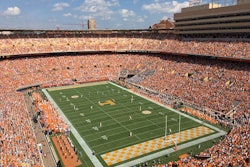Before choosing an outdoor playing surface, organizations need to understand the potential up-front and recurring costs associated with both natural and synthetic turf

Despite its reputation for fielding arguably the best high school football program in Louisiana over the past dozen years - with five District 2-5A championships in seven title-game appearances since 1993 - West Monroe High School made do with what head football coach and athletic director Don Shows describes as the worst facilities of any school its size in the state. In particular, the landlocked campus serving 1,900 students lacked enough natural square footage to adequately accommodate a variety of outdoor physical activities.
"Our P.E. classes had nowhere to go until football season was over. Our band had to practice on the baseball outfield. Our soccer teams had to walk three blocks from school to practice in a pasture," says Shows, who despite widespread public criticism invested $465,000 of bond-issue money into a synthetic-turf football field that was in place for the final two home games of the 2003 season. "Since we put that turf field down, it's used from 8 o'clock in the morning until about 5:30 or 6 in the evening, every day of the week. Even though it's a football field, it converts into a multipurpose field. That's the thing I see."
More high schools than ever are recognizing the value of synthetic turf these days, and colleges accustomed to pampering natural-grass fields with a high level of maintenance and a limited amount of play are taking a second look at synthetics, too. Why? Quality improvements in turf manufacturing have made systems featuring crumb rubber or a combination rubber/ sand infill and pliable polyethylene fibers a much more attractive playing surface to athletes in most sports (save ball-roll dependent field hockey) than the shortpile nylon carpets popularized in the 1960s and accepted as the synthetic standard for the next three decades. Moreover, today's synthetic turf is more affordable, not only in terms of industry competition (dozens of manufacturers are now vying for market share), but also materials (polyethylene is less expensive than nylon) and installation (adhesives represent a more time-efficient alternative to hand-stitched seams). All along, synthetic turf's promise of cost-effectiveness has continued to tempt athletic directors experiencing a dual shortage of green space and budget dollars.
But before deciding to uproot their grass fields in favor of synthetic turf, decision-makers on both college and high school campuses - as well as in municipal recreation departments - need to take several factors into consideration. "They have to think about what their needs are in comparison to what facilities they already have," says landscape architect Patrick Maguire, president of Geller Sport Inc., which consults on the installation of both natural- and synthetic-turf fields. "They have to assess what their different sports programs are currently and what their aspirations for those programs are in the future."
When its athletic facilities were designed in the 1960s, Anderson High School in Cincinnati fielded five sports teams. Today, it sponsors 45. Last year, Anderson athletic boosters oversaw the installation of a single synthetic-turf field - which, according to athletic director Mike Morgan, has exponentially expanded usage opportunities not only for Anderson's teams but the community at large. "Everybody wants to get on the turf," says Morgan, adding that the field includes permanently inlaid lines for football and soccer. Community teams (a lacrosse club among them) and high schools can rent the field for $60 an hour ($100 with lights) or $1,500 per high school game. Rental income totaled more than $22,000 in the field's first 12 months, according to Morgan. That amount, combined with an estimated $11,000 to $15,000 in maintenance savings, has seeded a fund that will finance replacement of the turf eight (or more) years down the road. And assuming no subsurface work is required, Morgan can expect turf replacement to cost as much as $1.50 less per square foot than Anderson's initial investment, according to Ron VanGelderen, president of the year-old Synthetic Turf Council, a nonprofit trade association. "It's a very positive outlook," Morgan says. "We can use it seven days a week without too much field impairment. On a Saturday, for example, we could have a football game and three soccer games right after that without having to do anything to the field."
In some cases, it only takes one team's limited use of a field to warrant a re-examination of synthetic turf's upside. The University of Michigan installed its first short-pile nylon field in 1969, replaced it with similar systems in 1975 and 1982, then decided to give something called Prescription Athletic Turf a try in 1991. The sand-based natural-grass surface, which featured a below-grade drainage vacuum that could handle 10 inches of rainfall per hour, performed flawlessly some years and awfully in others. A water-main break saturated one side of the field clear out to the hash marks hours before a game during the turf's inaugural year, but the field was perfectly playable by the scheduled noon kickoff. By 2002, though, large chunks of sod were kicking up under the strain of normal game conditions. Similar problems surfaced at a half-dozen other schools at roughly the same time, according to Mike Stevenson, Michigan's executive associate athletic director. "We decided that the best course for us to take here in the Upper Midwest, so that we could depend on a quality field in September, October and November, was to go with infill synthetic turf," Stevenson says, adding that Michigan's 2003 switch has had a big impact during the subsequent spring months, too. "Over the past five years, our team has been able to get outside on grass fields for spring ball no more than three of 15 dates, and some years it's been none at all until the actual spring game," Stevenson says. "This year we had snow, but we were out in the stadium 12 out of 15 dates because of that surface. It makes such a huge difference in terms of playability."
The new synthetic field cost roughly two-thirds the million-dollar price tag the natural one carried a dozen years earlier, but that was only the beginning of Michigan's savings. "We think we're saving between $130,000 and $170,000 a year in overhead - and a lot of that was painting," says Stevenson. The university no longer needs to contract with an outside painting company to touch up game lines and midfield and endzone logos on a weekly basis.
That's because inlaid yard lines composed of white fibers can be ordered as part of 15-foot-wide synthetic-turf rolls at additional up-front cost. Permanently inlaid football hash marks and team graphics, as well as a soccer field's perpendicular and arched lines, require more extensive onsite preparation and further expense. (One company, PermaLine Sports, has introduced permanent synthetic-turf game lines to natural grass fields in the interest of such ongoing maintenance savings.)
Meanwhile, regular mowing and periodic fertilization, aeration, overseeding and repair (when the field began to break down by season's end) were eliminated at Michigan, as was one full-time maintenance employee at a savings to the athletic department approaching $50,000.
That is not to say that the new field in place at Michigan Stadium - or any other infill system, for that matter - is maintenance-free. Michigan staff members groom the fibers weekly with a brush to stand them up and remove dirt and such common game-day debris as peanut shucks. A boom sprayer is used to apply diluted liquid fabric softener to the field before home games to knock down static electricity, which in unusually dry conditions can cause typically black crumb-rubber granules to creep up the fibers and into view. (Like inlaid lines, colored crumb rubber costs extra.) Irrigation is sometimes necessary to cool the turf on hot days, but far less water is used for this purpose than to keep grass plants alive. The closest procedure to aeration (conducted two or three times a season) involves an implement not unlike those used to till farm soil behind a tractor - with a rotating row of disks penetrating the infill and evenly distributing its mix of sand and crumb rubber - before a drag broom smoothes it over again.
Stevenson says more than 40 high schools in southeast Michigan are likewise benefiting from synthetic fields installed within the past two years. "Our high schools are playing three football games a week, two soccer games a week and lacrosse on these fields, in addition to practicing on them," he says. "In the past, one rainstorm would ruin a multiuse field for the whole year. Now it's a quality field all year long."
Installation of synthetic turf represents roughly half of the estimated $1.2 million to $1.5 million price tag currently under consideration by Los Alamos (N.M.) High School administrators, who hope to one day replace a natural-turf field, running track and lights in one comprehensive outdoor renovation project. "We're scrambling to figure out how we're going to finance something like this," says Los Alamos athletic director Robert Abney. "We have lots of irons in the fire, and that project is important, but it gets put off. This is a community that has the highest per capita number of PhDs in the country, and people in this area want to see data. Some express concern about injury. Some express concern about whether it will actually last 10 years. We're going to have to compile data and present it. I think the community overall is supportive, but it also recognizes that's a lot of money."
"It's a matter of justifying costs for what you're getting over time. When you look at it as an acquisition cost, it's totally different than when you look at it as lifecycle costing," says VanGelderen, whose 52-member Synthetic Turf Council represents synthetic turf manufacturers, suppliers and installers. One manufacturer's analysis puts the cost of installing and maintaining a natural-grass field for 10 years at $905,000. For its own synthetic-turf product, the same manufacturer estimates a 10-year lifecycle cost of $622,000. These figures do not take into consideration the inconvenience of downtime associated with maintenance procedures, inclement weather or field recovery.
Still, upfront costs hovering above the half-million mark might prove too great a deterrent for some would-be synthetic-turf purchasers. After all, an entire football field can be seeded for less than $500 - assuming that the field ideally sits dormant for a year (or at least two growing seasons) to allow for germination, maturation and the development of a thatch layer before the turf is durable enough for regular use.
Sodding a field allows instant playability at roughly 50 cents to $1 per square foot (compared to seed's 25 cents), but sod also needs time to adjust to its new soil surroundings before a fresh root system can take hold. In either case, ongoing maintenance needed to keep natural turf growing at a healthy rate in native soils requires a minimum $30,000 to $50,000 annual investment, according to Maguire, with some turfgrass caretakers spending considerably more and some woefully less. Sand-based natural turf requires even more aggressive cultural practices, particularly in terms of fertilization, and at even greater expense. And no matter what form it takes, natural turf ultimately leaves athletic departments and their staffs at the mercy of rising costs associated with labor and materials (think gasoline and fertilizer), as well as ongoing depreciation of a requisite armada of maintenance equipment.
You don't have to convince West Monroe's Shows that his new synthetic field is saving him man-hours on the mower; he's the man doing all the mowing. And he hasn't stopped trimming his workload. Using football gate receipts and other monies saved over the past 10 years, Shows has invested an additional $365,000 in two synthetic-turf practice fields - one 65 yards in length, the other 35. By limiting his campus's natural turf to one 100-yard practice field and a baseball field, Shows could afford to sell one of his school's two $30,000 fairway mowers.
If it weren't for the high cost of steel, Shows says he would have domed his synthetic-turf practice fields and created an indoor facility. That's just what administrators at Minnetonka (Minn.) High School are doing with their month-old synthetic-turf field. Scheduled to be in place from mid-November to early April, the dome allows school use of the field from 8 a.m. until 3 p.m., followed by the athletic department from 3 to 5 p.m. The dome is then available to rent from 5 to 10 p.m. on weekdays and from 7 a.m. to 10 p.m. on weekends. Proceeds are being channeled toward retiring the $3.1 million loan needed to complete the project, without imposing any burden on taxpayers, according to John Hedstrom, Minnetonka's activities director.
Given these examples of overhead reduction and revenue generation, it's no wonder proponents of synthetic turf often talk of fields "paying" for themselves. Says Shows, "I feel that at the high school level, a field can actually pay for itself in six or seven years. But you cannot put a value on how much our field is being used. Our ROTC goes down there and marches on it. I had never even thought about that. The band gets on it three days a week. The boys' and girls' soccer teams are on it almost every day. All the P.E. classes are on it. Actually, the football team uses it less than the rest of the student body."
One is left to wonder whether we are in the midst of a synthetic-turf renaissance - if the promise first heard in the 1960s that synthetics represented the future of outdoor athletic fields still echoes today. "I would say we're a lot closer to that being a truth," says Maguire, who estimates a natural-turf field's tolerance at 50 to 60 events a season. "In many respects, we look at building a synthetic field as being equivalent to building two or three natural-grass fields in the amount of use and number of programs you can place on it without fear of damaging it."
Has synthetic turf severely damaged natural grass? No more than a certain grass system has damaged its own industry, according to A.J. Powell, extension specialist in the University of Kentucky's turf department of agronomy. "I contend that one of the reasons we're seeing this great influx of infill systems is because the expense got so high with the sand-based system and we saw so many failures with it," Powell says. "Sand-based fields sort of ruined our reputation."
Powell's explanation for the failures is simple: Sand-based turf first developed for golf courses and exhibiting a relatively straight, non-fibrous root system can't withstand the forces applied to it by 300pound football players. More troubling still is the fact that the next-best natural alternative has yet to emerge. "We all discuss it a lot, but I'm not sure that we can come up with something in a natural grass situation that's going to give us maximum drainage and great rooting and be cheaper to maintain than infill," Powell says. "I'm just not sure we can do that."
In October, ASTM International's F08.64 subcommittee on natural playing surfaces approved standards for the construction of high-performance sand-based fields - the first-ever construction standards for natural grass applications other than lawn tennis courts. The new standards, which cover a variety of sand-based construction options, address builders' ill-fated attempts to modify golf course specifications to fit the demands of playing fields, according to turf agronomist Michael Depew, the subcommittee's technical contact. Maintenance standards are next on the F08.64 to-do list. "The natural fields industry as a whole has been lagging behind, and we're in catch-up mode," Depew says. "Standards were established for synthetic surfaces a lot sooner than for natural surfaces, even though we've been playing on natural surfaces a lot longer."
Have turfgrass specialists felt at all threatened by the specter of a synthetic-turf takeover? "I think to some extent they do," says Suz Trusty, former director of communications for the Sports Turf Managers Association. "It's a matter of much debate. It will be something that STMA will be touching on at its conference again this year [Jan. 19-23 in Phoenix], just as it did last year. What's out there? What are the long-term effects of it? Most of the members are looking at the new-generation fields as a tool that will allow them to make the best use of their natural-turf fields. Some of them are designing stadium fields as the synthetic surface, while still keeping natural-turf surfaces for practices; some of them are approaching it the other way around."
"They should not see the infill systems as great competition. They should see them as a big help, because the infill systems for the most part are going into places where it is impossible to maintain a decent turf," Powell says, adding of turfgrass caretakers, "They still have all the practice fields to maintain."
Grass is far from dead. Natural turf remains the preferred surface among many athletes, and at many levels of competition. Says Maguire, "If I was going to play in the Super Bowl or the World Cup and you asked me, 'What do you want to play on.' I would absolutely say, 'I want to play on a natural-grass field.' But it's not realistic to think that high schools or even colleges can expect to have a natural-grass field be in ideal condition for all of their events."
"Certainly, our coaches feel that if we could guarantee them a quality grass field throughout the season, they would prefer to play on grass," adds Michigan's Stevenson. "But I think this infill is so close to the performance of grass that it's clearly going to be the field of the future."





































